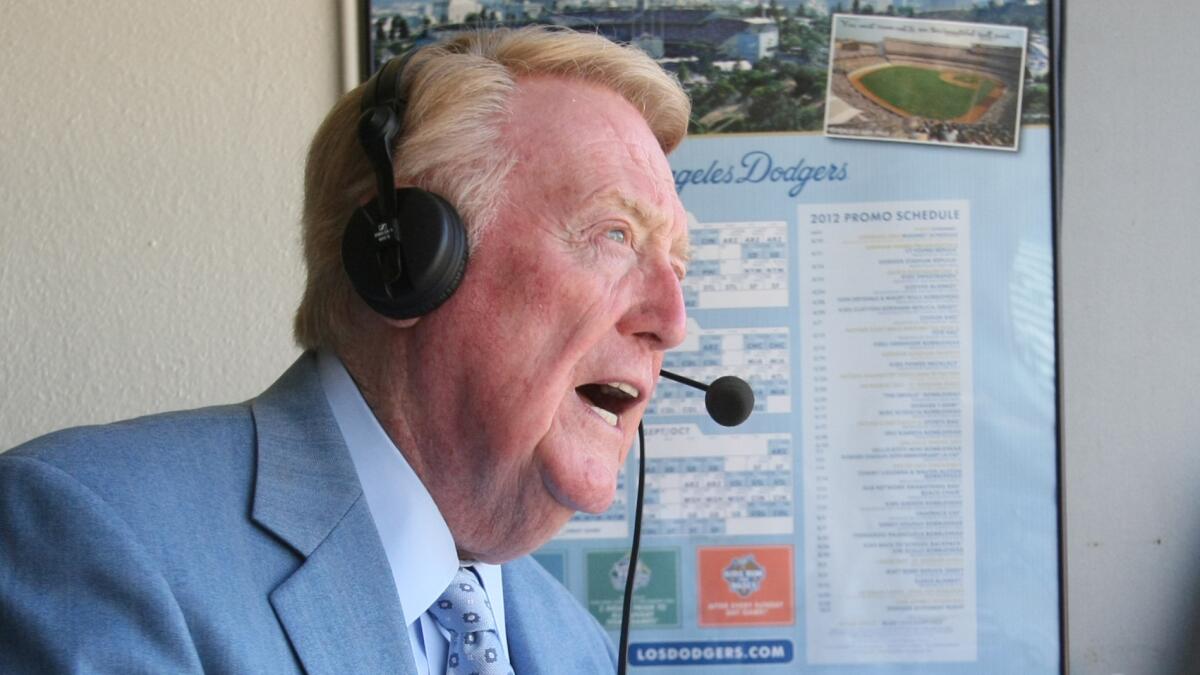Vin Scully’s ‘air apparent’ in the booth is Joe Davis — no pressure, of course

- Share via
Too many of today’s sports announcers are yakking Yorkies who seem to have learned nothing from the Hall of Fame talent in L.A. To a man, Vin Scully, Dick Enberg, Al Michaels and Chick Hearn found the humanity, mythology and mirth in the world of sports.
By comparison, today’s announcers are statistical savants. From the network level on down, games sound as if they are being called by technically proficient accountants.
The change in tone is a reflection of the data analysis that has taken over sports, particularly baseball. Perhaps it is also a reflection of the state-of-the-art camera work that leaves little for the announcers to point out beyond what viewers can see for themselves.
As I’ve long said, the most important individual on a baseball team isn’t the guy hitting in the three-hole, or the cheetah playing center field. It’s not even the manager or the general manager. It is the talent behind the microphone.
Over 162 games, 1,500 innings, nearly 600 hours, he is the ambassador to the team. He fills the too-long pauses between pitches and serves as the affable drinking buddy to the fan at home. The bond is not just a covenant. It’s kismet; it’s advanced chemistry.
The franchises with the deepest fan loyalty have been built on the backs of the game’s best announcers: Harry Caray and Jack Buck in St. Louis, Jack Brickhouse and Caray in Chicago, Red Barber and Mel Allen in New York, Ernie Harwell in Detroit. Rascals, some of them; entertainers all.
That makes next year such a significant season for the Dodgers. To take Scully’s chair, the Dodgers have tapped Joe Davis, who spent this season auditioning for the role. Though the Dodgers haven’t officially said, and will make nothing of the transition, Davis is Scully’s air apparent, so to speak.
“It’s a roll of the dice,” says Daniel T. Durbin, of USC’s Institute of Sports, Media and Society. “Anything after Scully is a roll of the dice. And this move makes the team seem as if they are skipping the seemingly easy path of getting name broadcasters from ESPN or Fox who still, of course, would be no Vin Scully in favor of trying to grow a new Scully at home.”
As tough acts to follow, this might be the toughest since Moses left Egypt. Davis is a promising young pro, with enough potential to develop into something better than just another statistical savant.
So, good luck, Davis. Here’s hoping that in six decades, they’ll be talking about whether anyone can ever fill your shoes.
No Scully soon and still no TV
Tell me, does stem cell therapy work on a broken heart? Because that’s what’s going to happen to me if Scully’s final season blows by without him appearing on as many TVs as possible.
From all indications, there is still no movement on the Dodger TV blackout. Time Warner Cable and DirecTV will not discuss whether talks are progressing, though the Dodgers remain hopeful that the Charter-TWC merger will shake things up.
Hanging in the balance is a good chunk of Stan Kasten’s professional legacy. The Dodgers president came to L.A. with a world-class resume. That would be severely tarnished if a significant chunk of fans were denied the final three years of Scully, the best baseball voice of all time.
Most Southland fans will get their first look at the Rams during Saturday’s ESPN national telecast of their exhibition debut.
The remaining three exhibition games will be on Channel 2 and produced by Altitude, a regional sports network also owned by the Rams’ chief check writer, Stan Kroenke. Andrew Siciliano, Eric Dickerson and Marshall Faulk will handle duties in the booth. Jill Arrington and Dani Klupenger will work the sidelines. Producer Mike Rigg and director Scott Bay will handle the camera work, commercial timeouts, replays and all the other production work associated with a telecast.
Altitude’s arsenal includes 14 cameras, including two super slow-motion units, and two cameras mounted on carts for shots up and down the sidelines. With the Rams on the sideline nearest the press box, look for cart camera shots to capture much of the sideline action.
“Coming back to L.A., the history of the team will be a focus,” says Ken Miller, the regional network’s vice president of production and programming. “You always want to capture the feel of the location ... the star power. Obviously, we’ll be searching for that.”
On radio, J.B. Long, Maurice Jones-Drew and D’Marco Farr will call Rams’ exhibition and regular-season games, on 710.
By the way, can you name the sportscasting legend, also retiring this year, who made a mark early in his career doing Rams’ radio?
Enberg, of course.
Oh my….
Twitter: @erskinetimes
More to Read
Are you a true-blue fan?
Get our Dodgers Dugout newsletter for insights, news and much more.
You may occasionally receive promotional content from the Los Angeles Times.









